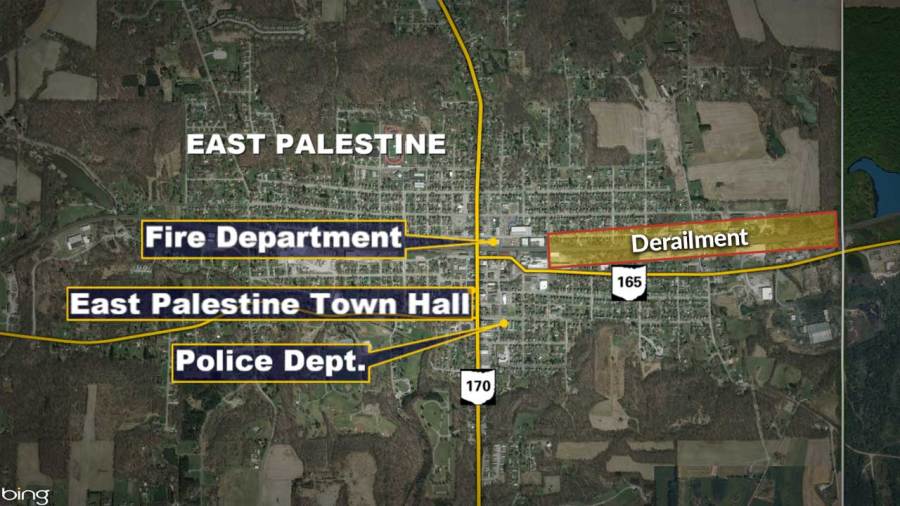East Palestine's Lingering Threat: Toxic Chemical Residues In Buildings After Derailment

Table of Contents
The Extent of Contamination: Assessing the Spread of Toxic Chemicals
The derailment released a cocktail of hazardous substances, including vinyl chloride, butyl acrylate, and other volatile organic compounds. These chemicals, known for their persistence and potential for bioaccumulation, readily infiltrated porous building materials like drywall, insulation, carpeting, and fabrics. Understanding the full extent of the contamination is a monumental challenge.
- Persistence in Building Structures: Vinyl chloride, for instance, can penetrate building materials and remain trapped within their pores, even after initial cleanup efforts. This creates a long-term exposure pathway for residents. Butyl acrylate residue, similarly, can persist, leading to ongoing health concerns.
- Challenges in Quantification: Accurately identifying and quantifying the levels of toxic chemical residues within buildings presents significant technical hurdles. The presence of trace amounts requires sophisticated testing methods capable of detecting these chemicals at extremely low concentrations.
- Advanced Testing Needs: Advanced techniques, such as high-performance liquid chromatography (HPLC) and gas chromatography-mass spectrometry (GC-MS), are necessary to detect trace amounts of these persistent organic pollutants and assess the full scope of the contamination. Further research into effective and efficient detection methods is crucial.
Health Risks Associated with Long-Term Exposure to Residues
Prolonged exposure to the toxic chemical residues from the derailment poses serious health risks to residents, both short-term and long-term. The specific effects vary depending on the chemical involved, the concentration, and the duration of exposure.
- Respiratory Problems: Exposure to vinyl chloride and other volatile organic compounds can lead to respiratory issues, including coughing, wheezing, and shortness of breath.
- Skin Irritations: Direct contact with contaminated surfaces can cause skin irritations, rashes, and allergic reactions.
- Neurological Issues: Some of the released chemicals are known neurotoxins, potentially leading to neurological problems such as headaches, dizziness, and cognitive impairment.
- Increased Cancer Risk: Vinyl chloride, in particular, is a known carcinogen, significantly increasing the risk of various cancers, including liver cancer.
- Reproductive Health Concerns: Exposure to certain chemicals can negatively impact reproductive health, leading to fertility problems and birth defects. Further research is crucial to understand the full extent of these risks. These toxic chemical health risks demand immediate and comprehensive attention.
Remediation and Cleanup Efforts: Addressing Toxic Chemical Residues in Buildings
Cleaning up contaminated buildings is a complex and challenging undertaking. The nature of the chemicals and the porous nature of many building materials complicate the process, requiring specialized techniques.
- Specialized Cleaning Techniques: Effective remediation may involve techniques such as vapor extraction, thermal desorption, and chemical neutralization, depending on the type and location of the toxic chemical residues.
- Decontamination Procedures: Rigorous decontamination protocols are essential to minimize the spread of contamination and prevent further exposure. This includes proper disposal of contaminated materials.
- Waste Disposal Challenges: The disposal of contaminated building materials poses a significant environmental challenge, requiring safe and environmentally sound methods.
- Cost and Feasibility of Remediation: The cost of comprehensive remediation can be substantial, impacting the feasibility of complete cleanup for some residents.
- Long-term Monitoring: Continuous monitoring of air and water quality, along with regular testing of building materials, is vital to assess the effectiveness of remediation efforts and ensure long-term public safety. Effective remediation strategies are crucial to mitigate the long-term impact.
The Role of Government Agencies and Accountability in Addressing the Issue
Government agencies, primarily the EPA, bear the responsibility for overseeing cleanup efforts, ensuring public safety, and holding responsible parties accountable. Transparency and accountability are paramount.
- EPA Oversight and Regulations: The EPA must enforce stringent regulations, monitor cleanup progress, and ensure that remediation efforts meet established standards.
- Funding for Remediation Projects: Adequate funding is crucial to support comprehensive cleanup and long-term health monitoring programs.
- Investigation into the Cause of the Derailment: A thorough investigation is needed to determine the cause of the derailment and implement measures to prevent future incidents.
- Compensation for Affected Residents: Affected residents deserve fair compensation for their losses, including medical expenses and property damage.
- Long-term Health Monitoring Programs: Establishing a robust long-term health monitoring program is essential to track the health effects of exposure and provide appropriate medical care. This emphasis on government accountability is critical.
The Continuing Threat of Toxic Chemical Residues in East Palestine
The East Palestine train derailment serves as a stark reminder of the devastating consequences of industrial accidents. The lingering threat of toxic chemical residues in buildings underscores the need for thorough and comprehensive cleanup efforts, coupled with long-term health monitoring and robust regulatory oversight. The severity of the situation demands sustained attention and action to ensure the health and well-being of affected residents. We must advocate for stronger regulations, improved safety measures, and increased funding for toxic chemical residue remediation efforts in East Palestine and across the nation. Stay informed about the situation, support the affected community, and demand accountability from responsible parties to prevent similar tragedies in the future. Addressing East Palestine contamination effectively requires a sustained collective effort.

Featured Posts
-
 Epic Mma Showdowns 5 10 And 25 Minute Fights You Shouldnt Miss Mma Torch
May 11, 2025
Epic Mma Showdowns 5 10 And 25 Minute Fights You Shouldnt Miss Mma Torch
May 11, 2025 -
 Best Practices For Automated Visual Inspection Of Lyophilized Vials
May 11, 2025
Best Practices For Automated Visual Inspection Of Lyophilized Vials
May 11, 2025 -
 Kritiki Jay Kelly I Nea Tainia Me Kloynei Kai Santler
May 11, 2025
Kritiki Jay Kelly I Nea Tainia Me Kloynei Kai Santler
May 11, 2025 -
 Ataque De Avestruz A Boris Johnson En Texas Detalles Del Incidente Familiar
May 11, 2025
Ataque De Avestruz A Boris Johnson En Texas Detalles Del Incidente Familiar
May 11, 2025 -
 Analyzing Chaplins Contribution To Ipswich Towns Success
May 11, 2025
Analyzing Chaplins Contribution To Ipswich Towns Success
May 11, 2025
